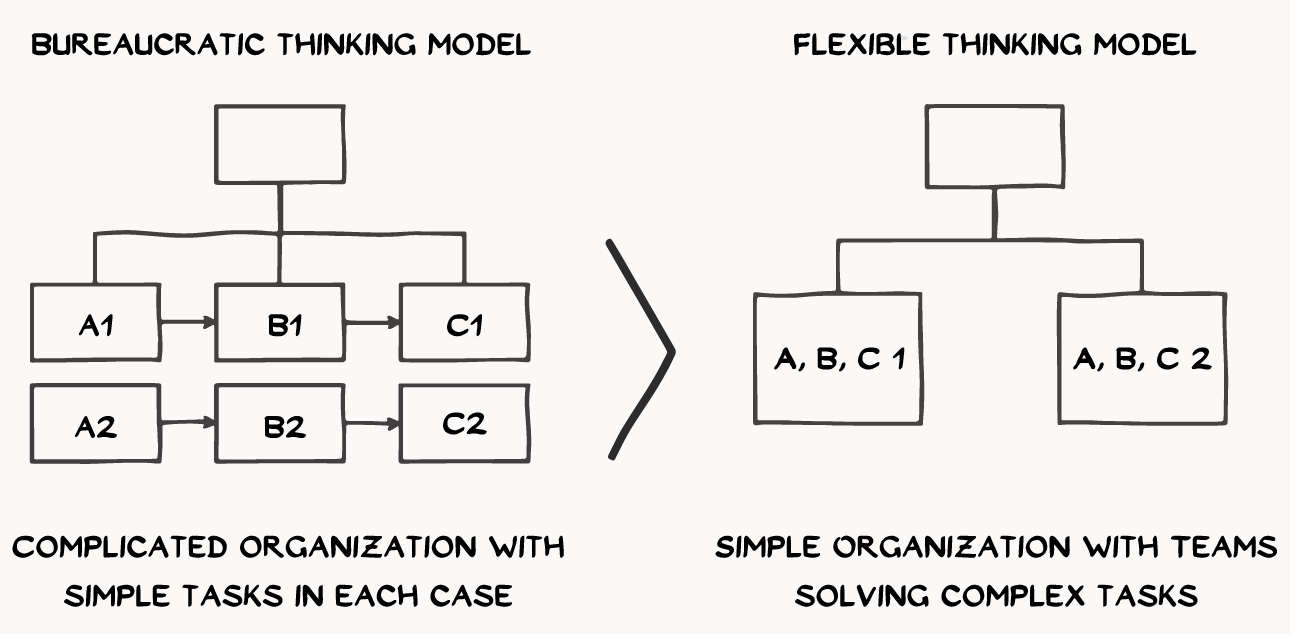
5 success factors for the successful implementation of an agile organization at department level
Challenge
An international financial services provider is looking to digitize its core processes to realize efficiencies and better serve customer needs. For example, the expressed customer needs in account opening for funding and financing are to get better transparency on the status and more support in collecting information. But the unspoken true needs may be quite different: If it only takes me a day to open, transparency is no longer needed; if complexity in information gathering is reduced, support can also be reduced. These goals are being driven in one area in four countries simultaneously, first identifying business problems like the one described above, and then developing and implementing solutions (such as robotics, machine learning).
Even though previous measures meant that tasks were structured and descriptions were available for many conceivable cases and work steps, the management team perceived a growing dissatisfaction among employees with the current ways of working. In addition, the full potential of the solutions was not being exploited, and the solutions often caused problems during implementation and support, because neither time nor ownership had been planned for this.
Even more standardization and even more rules and work regulations did not bring the desired success - instead, the division strived for an Agile organization.
Results
- Cost savings of several million € through robotics and machine learning solutions
- Net Promoter Score (NPS) >85 from projects focused on customer satisfaction
- Increase of employee satisfaction index from 70% to 85% (Employee Pulse survey
A few examples of success factors from the practice of this project
Success factor - E2E DevOps teams
The organization, which previously had a strong division of labor, was completely transformed and an agile role model was implemented. The guiding principle for the implementation was the idea of moving away from simple tasks and a complicated organization to a simple organizational structure in which a team is entrusted with complicated tasks. Today, each team accompanies a challenge along the entire value stream, from business analysis to support and improvement of solutions.

Success factor - trust through transparency
In order to be faster and more agile, decisions should be made where the best information is available on the one hand, but also where there are skills and the will to do so. In the agile world, managers are required to have trust in their employees and delegate decisions to the team. This only works if the framework for the team is clear and if trust is built. A high level of transparency on decisions and the most important content promotes trust. This way, the team can show that they are handling the situation responsibly and the managers can support them instead of controlling them.
Success factor - "Safe to try."
To ensure that no business-threatening decisions are made, the team defined a waterline for itself. Above the waterline, changes and trial and error are not critical and are decided and executed independently. Below the waterline, there could be massive consequences, so joint decisions are made here.
Success factor - Understanding the target culture
An agile organization demands fundamentally different behaviors from stakeholders. The behaviors add up to the often cited corporate culture. If you want to reap the benefits of agility, many of these behaviors must change, and with them the corporate culture. Creating transparency about the current culture at an early stage and comparing it with a common culture model means that those involved can deal with it at an early stage, know what is required of them and at which points less conducive behaviors dominate everyday life. As a result, change can take place more consciously and thus more quickly and with less resistance.
Success Factor - Letting the Team (Constantly) Re-think the Organization
The design of the agile organization is best left to the team itself - this allows ownership and a completely different basic attitude to the content of the change to emerge. An agile organization is characterized by adaptability - this also applies to its own elements. So, to ensure that it can respond adequately to new circumstances, mechanisms for constant adaptation are implemented.
If you have any questions or would like to discuss the topic of agility in the financial services industry further, please contact the author (Martin Thalheim, Senior Manager at Martin.Thalheim@ums-gmbh.com) or get in touch with the UMS Finance Team at finance@ums-gmbh.com.
We look forward to it!